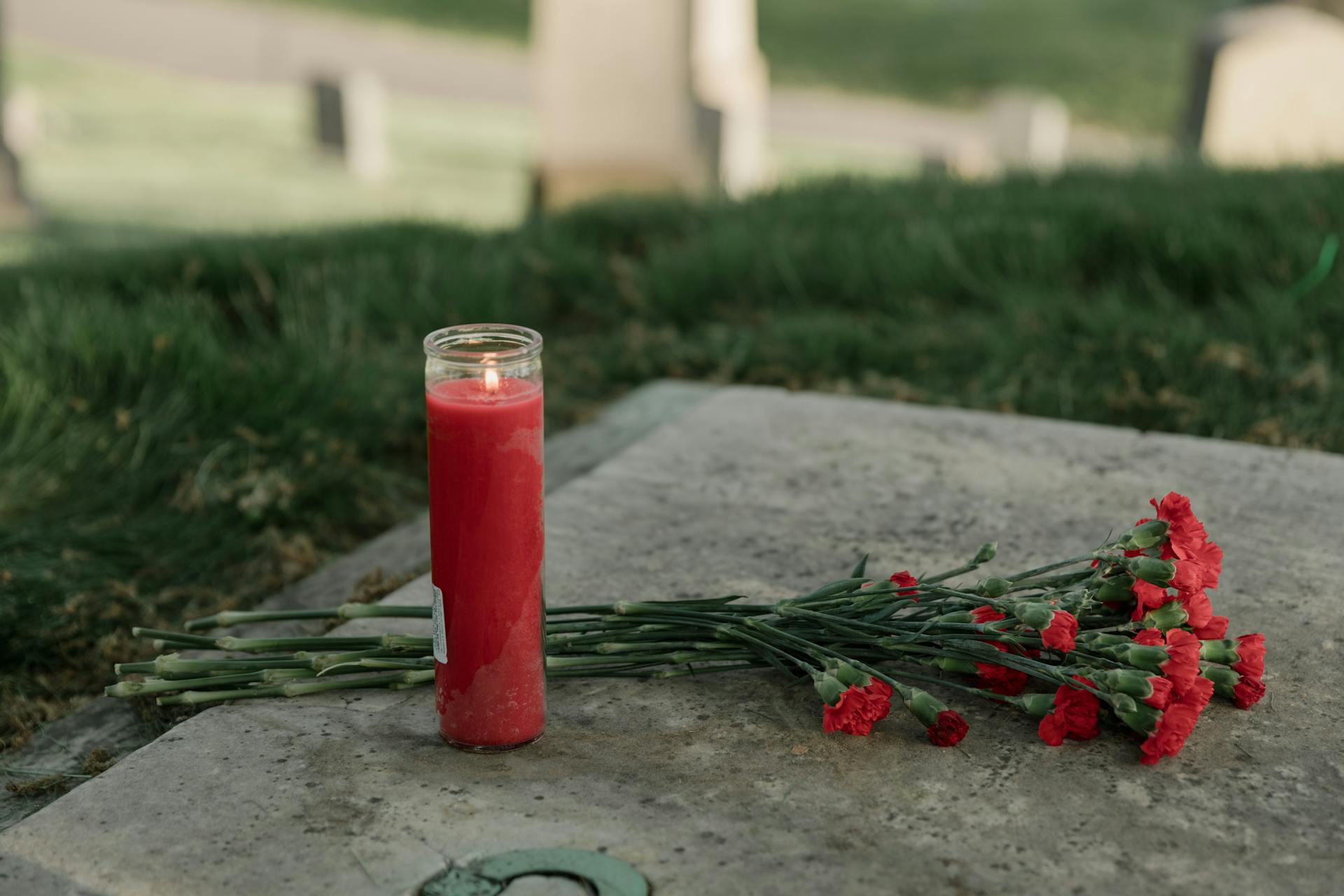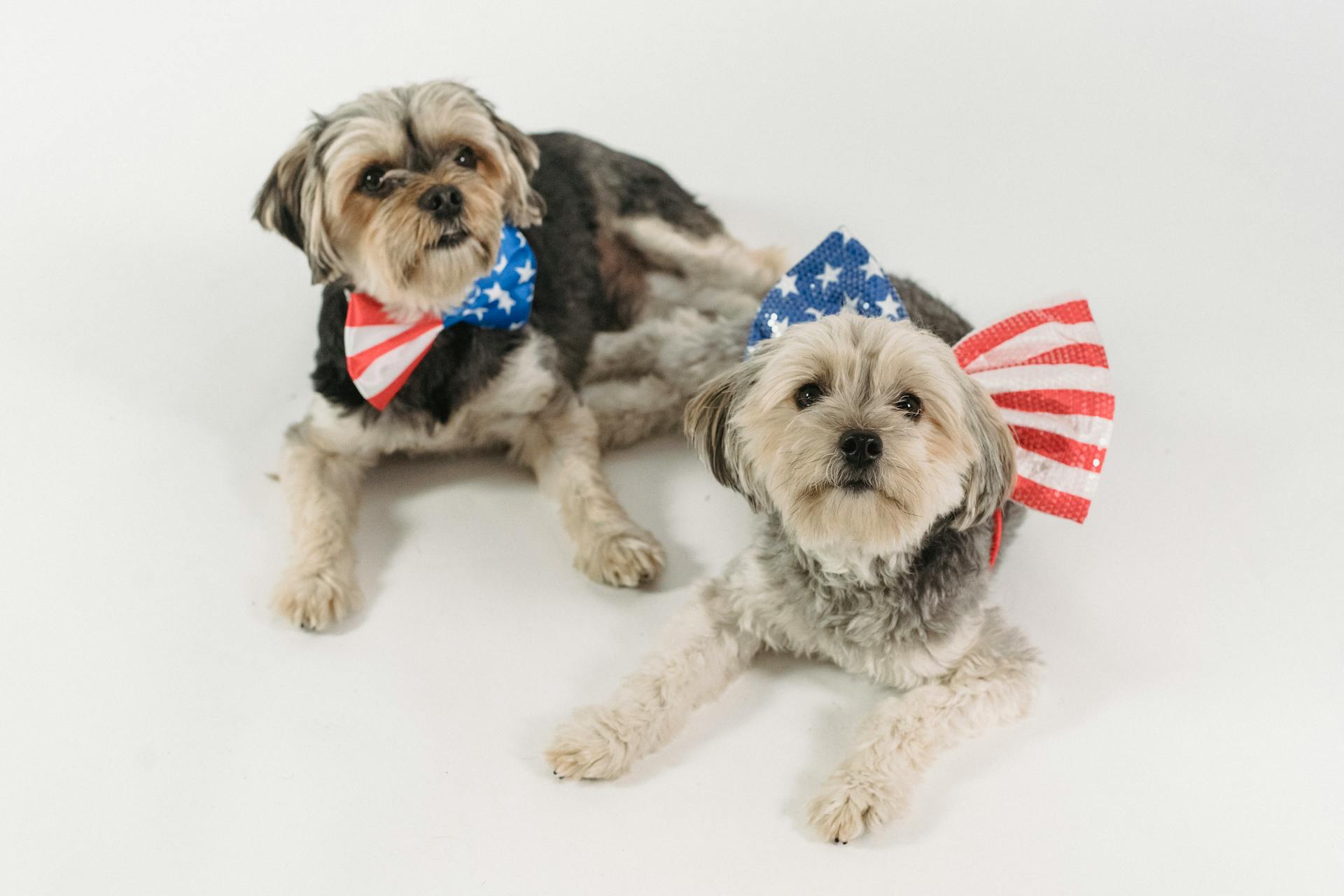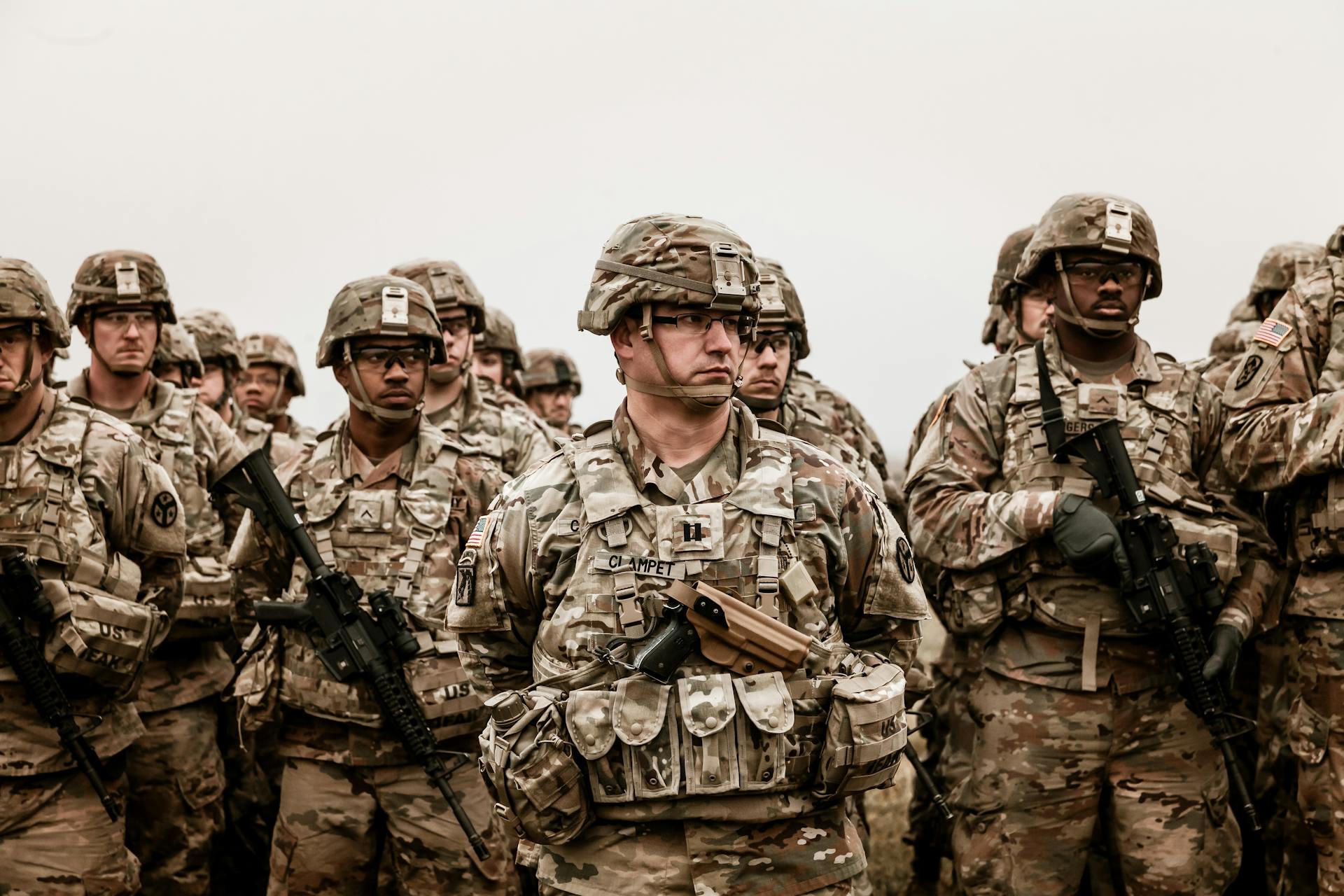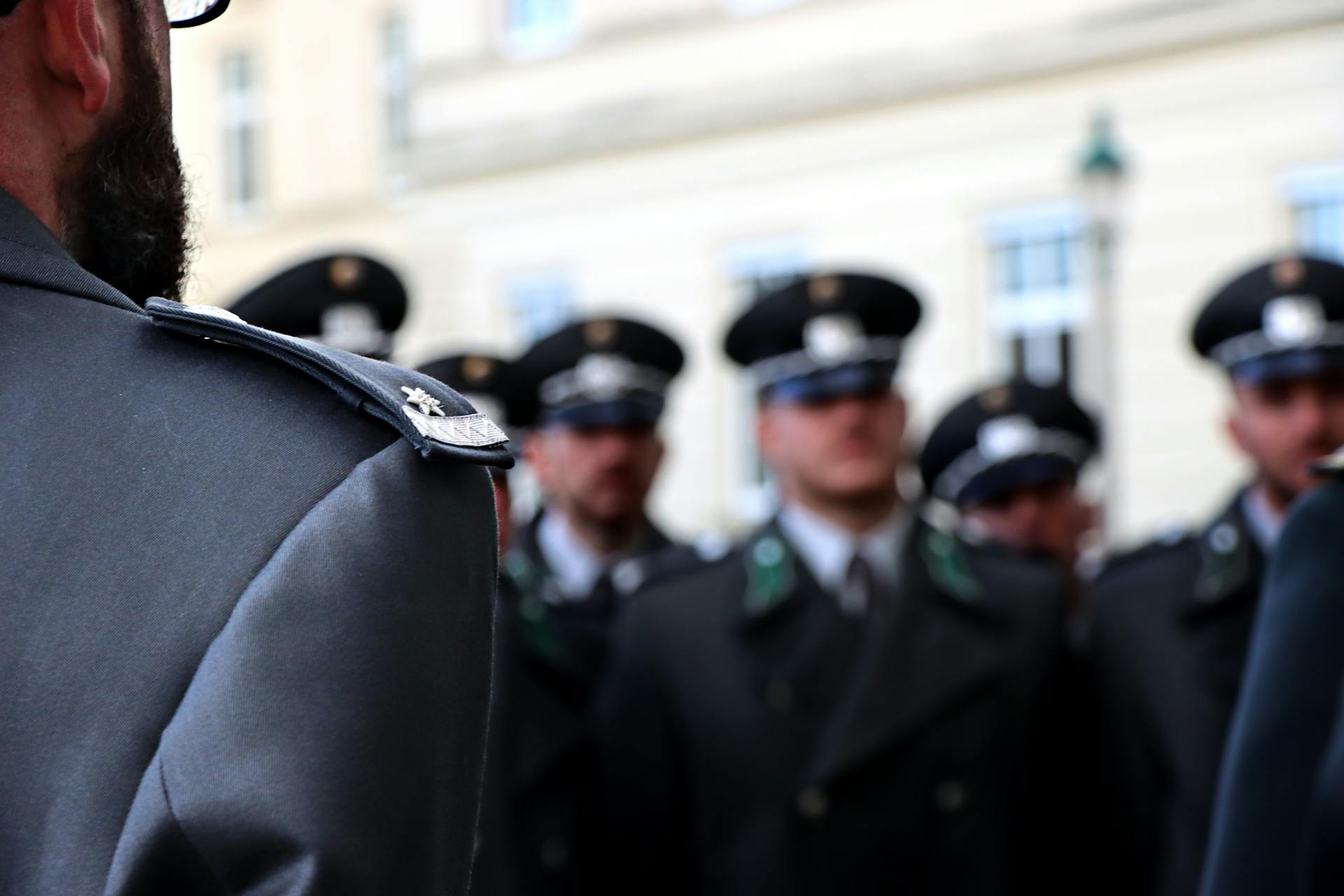
Sergeant Stubby was a Boston Terrier who became the first dog to be promoted to sergeant in the US Army during World War I.
Stubby's journey began in 1917 when he was adopted by a soldier named John Robert Conroy, who was training at Yale University.
Stubby's keen senses and instincts proved invaluable in detecting gas attacks and alerting his unit to potential dangers.
Stubby's heroics didn't go unnoticed, and he quickly became a beloved mascot for the 102nd Infantry Regiment.
Early Life and Military Service
Stubby was a dog of uncertain breed, likely with some Boston Terrier ancestry, found wandering the Yale University campus in New Haven, Connecticut, in July 1917.
He was discovered by Corporal James Robert Conroy, who developed a fondness for him and hid Stubby on board the troop ship when it was time to ship out to France.
Stubby served with the 102nd Infantry Regiment in the trenches in France for 18 months, participating in four offensives and 17 battles.
He entered combat on February 5, 1918, at Chemin des Dames, north of Soissons, and was under constant fire, day and night, for over a month.
Stubby was wounded in the foreleg by retreating Germans throwing hand grenades in April 1918, but recovered and returned to the trenches.
He learned to warn his unit of mustard gas attacks and locate wounded soldiers in no man's land, and was even nominated for the rank of sergeant by his unit's commander for capturing a German spy in the Argonne.
Early Life
Stubby was described in contemporaneous news items as a Boston Terrier or "bull terrier" mutt.
Stubby's uncertain breed is likely due to the evolving family of Boston Terriers, a breed so new that even its name was in flux.
The brindle-patterned pup probably owed at least some of his parentage to the Boston Terriers, a breed that was still finding its identity.
Stubby was found wandering the grounds of the Yale University campus in New Haven, Connecticut, in July 1917.
You might like: Where Are Yorkshire Terriers from

He hung around as the men of the 102nd Infantry drilled and trained, and one soldier in particular, Corporal James Robert Conroy, developed a fondness for him.
Stubby's fate might have been different if not for Conroy, who hid him on board the troop ship as they shipped out.
Upon discovery by Conroy's commanding officer, Stubby saluted him as he had been trained to in camp, and the commanding officer allowed the dog to stay on board.
Military Service
Stubby served with the 102nd Infantry Regiment in the trenches in France for 18 months. He participated in four offensives and 17 battles.
He entered combat on February 5, 1918, at Chemin des Dames, north of Soissons. He was under constant fire, day and night, for over a month.
In April 1918, during a raid to take Seicheprey, Stubby was wounded in the foreleg by retreating Germans throwing hand grenades. He was sent to the rear for convalescence.
He returned to the trenches after recovering from his wounds. He then learned to warn his unit of mustard gas attacks and locate wounded soldiers in no man's land.
Stubby was injured by mustard gas in his first year of battle. He returned with a specially designed gas mask to protect him.
He became very adept at alerting his unit when to duck for cover due to his ability to hear the whine of incoming artillery shells before humans.
Sergeant Stubby's Story
Stubby, the spy detector, was a hero in every sense of the word. He caught a German spy who was mapping out Allied trench locations, allowing his human comrades to capture him.
For his heroic efforts, Stubby was promoted to the rank of sergeant, the first dog to be promoted to the position. He was quite the soldier, wasn't he?
In April 1918, Stubby's unit was under attack during a battle near the German-occupied town of Seicheprey, France. He was wounded in his chest and leg by shrapnel.
During his treatment at a Red Cross hospital, Stubby doubled as a therapy dog, visiting recovering soldiers to lift their spirits. He was a true morale booster.
The women of the town of Chateau-Thierry made Stubby a blanket and medals to thank him for his bravery. He was quite the celebrity, even among the locals.
Postwar Life and Legacy
After the war, Stubby became a celebrity, leading U.S. troops in parades and meeting with U.S. Presidents Woodrow Wilson, Warren G. Harding, and Calvin Coolidge.
He was awarded many medals for his heroism, including a medal from the Humane Society presented to him by Gen. John Pershing.
Stubby spent his time congratulating and being congratulated, traversing the streets of Paris, where he was recognized by hundreds of French, English, Australian, and American soldiers.
He met President Wilson on Christmas Day, and Stubby, being the gentleman he was, offered his paw.
Stubby continued to live with Conroy while he attended law school at Georgetown University in Washington, D.C., where he became the school's mascot.
Stubby died on March 16, 1926, at about the age of 10, and was memorialized in written obituaries in The New York Times and The Washington Post.
His remains were preserved and are on display at the Smithsonian National Museum of American History.
Stubby's story was featured in a children's book, Sergeant Stubby: How a Stray Dog and His Best Friend Helped Win World War I and Stole the Heart of a Nation (2014), written by Ann Bausum.
In 2018, he was the subject of an animated documentary titled Sgt. Stubby: An American Hero, directed by Richard Lanni.
After his death, Stubby received an obituary in the New York Times, which was half a page long, much longer than the obituaries of many notable people of that time period.
He was also the subject of a portrait by "Capitol artist" Charles Ayer Whipple.
Stubby was featured in the Brave Beasts exhibit at the Legermuseum in Delft, The Netherlands from 2008 to 2009.
A brick was placed in the Walk of Honor at the Liberty Memorial in Kansas City to commemorate Sergeant Stubby on Armistice Day in 2006.
See what others are reading: Dogs in the American Revolutionary War
Stubby was the subject of at least four books.
In 2014, BBC Schools WWI series used Stubby as a Famous Figure to help teach children about the war, along with creating an animated comic strip to illustrate his life.
Stubby has his portrait on display at the West Haven Military Museum in Connecticut.
The descendants of Robert Conroy dedicated a life-size bronze statue of Stubby named "Stubby Salutes", by Susan Bahary, in the Connecticut Trees of Honor Memorial at Veteran's Memorial Park in Middletown, Connecticut, in May 2018.
The statue pays tribute to fallen Connecticut veterans, where both Stubby and Robert Conroy are from.
Stubby attended Georgetown University Law Center along with Conroy, and became the Georgetown Hoyas' team mascot.
He would nudge a football around the field at halftime, entertaining the fans.
Stubby died in his sleep in March 1926.
His remains were preserved via taxidermy, and his cremains were sealed inside of the mount.
Conroy later presented Stubby to the Smithsonian in 1956.
The taxidermy mount of the dog is part of the permanent collection at the Smithsonian National Museum of American History and is currently on display in their “Price of Freedom: Americans at War” exhibit.
If this caught your attention, see: Laika Dog Statue
Media and Recognition
Sergeant Stubby's media presence is a testament to his enduring popularity. He was the first dog to be promoted to sergeant in the US Army, and his story has been widely recognized.
Stubby's image has been featured in various forms of media, including a 1919 film called "My Four Years in Germany" where he is seen on the battlefield. He even has a bronze statue at the Smithsonian National Museum of American History.
The Smithsonian National Museum of American History has a collection of artifacts related to Stubby, including his collar, a gas mask, and a bronze statue.
Curious to learn more? Check out: Pit Bull: the Battle over an American Icon
Animated Film
The animated film Sgt. Stubby: An American Hero is a remarkable tribute to the life of a heroic dog. The film features the voices of Logan Lerman, Helena Bonham Carter, and Gérard Depardieu.
The animation was made by the studio Mikros Image and produced by Fun Academy Media Group. This collaboration resulted in a high-quality film that received high marks from film critics.
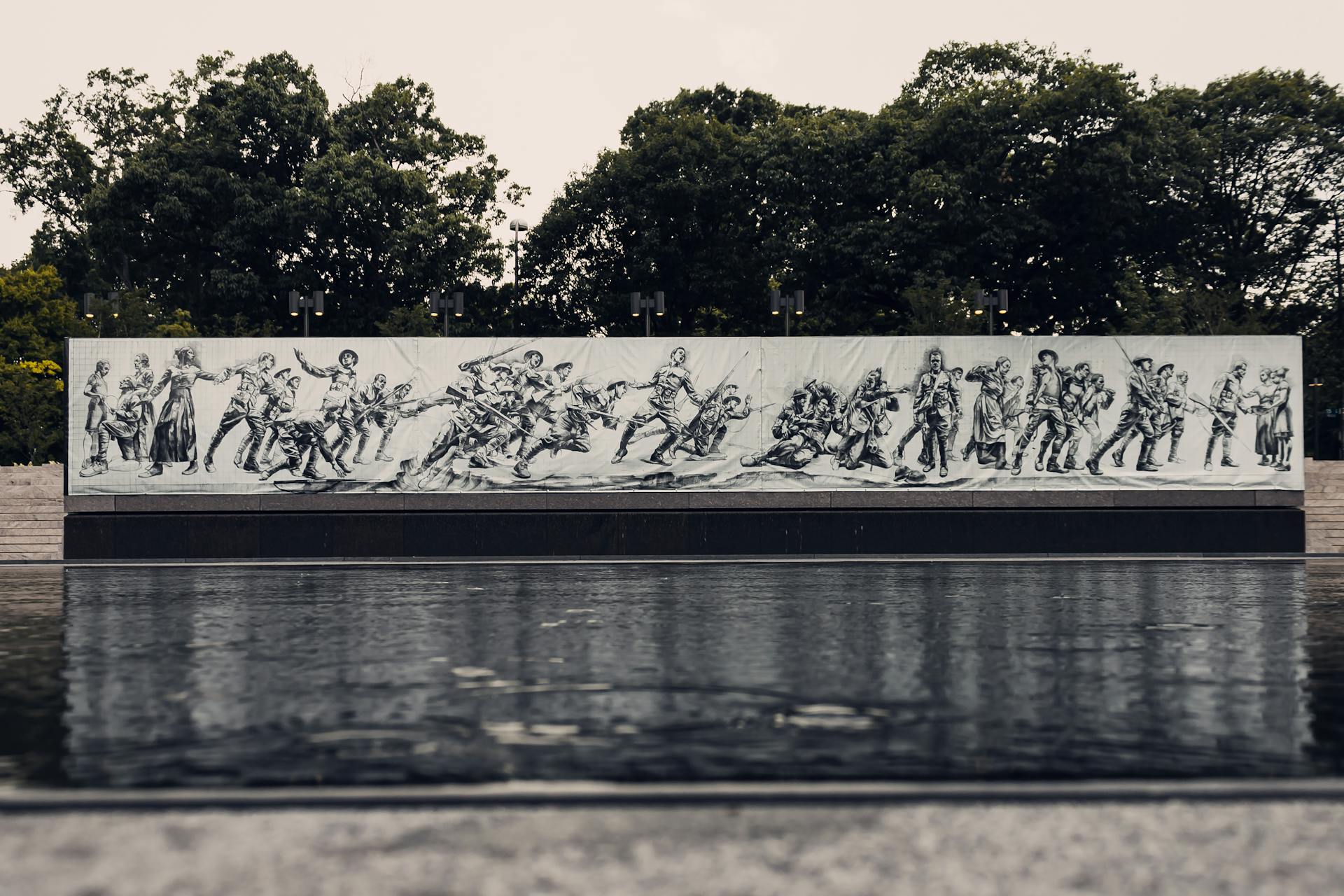
The film's music was composed by Patrick Doyle, an Academy Award nominee. This talented musician brought the story to life with his beautiful soundtrack.
The film was officially endorsed by several high-profile institutions, including the Humane Society of the United States and the United States World War One Centennial Commission. These endorsements speak to the film's quality and historical significance.
Here are some notable awards and recognition the film received:
- The Parents' Choice Foundation Gold Award
- The Dove Foundation's All Ages Seal of Approval
Mascots
Mascots are a big part of media and recognition, especially in sports.
Many sports teams have mascots that are designed to represent their team's personality and style. For example, the Philadelphia Eagles have a mascot named Swoop, a bird who loves to fly and cheer on the team.
Mascots can be live animals or costumed characters, and they often perform at games and events. The San Diego Zoo has a live monkey mascot named Bongo, who is a beloved part of the zoo's community outreach program.
In some cases, mascots can even have their own social media presence, with thousands of followers who love to see their antics and updates. The Denver Broncos' mascot, Thunder, has a huge following on Twitter and Instagram.
Mascots can also be used to promote a brand or product, such as the Kool-Aid Man, a anthropomorphic pitcher of Kool-Aid who has been a beloved character for decades.
Frequently Asked Questions
Where is Sgt Stubby now?
Sgt Stubby is on display at the Smithsonian National Museum of American History in the "Price of Freedom: Americans at War" exhibit. The taxidermy mount of the heroic dog is part of the museum's permanent collection.
Did Sergeant Stubby salute?
Sergeant Stubby saluted his fellow soldiers with a modified dog salute, placing his right paw on his right eyebrow. This unique gesture became a beloved part of his military experience.
Did Sergeant Stubby catch a German spy?
Sergeant Stubby caught a German spy, but it was not a spy, rather a soldier in hiding. Stubby's bravery led to the soldier's capture, earning him recognition for his heroic actions.
Sources
- https://www.britannica.com/biography/Sergeant-Stubby
- https://www.badassoftheweek.com/stubby
- https://slate.com/news-and-politics/2014/05/dogs-of-war-sergeant-stubby-the-u-s-armys-original-and-still-most-highly-decorated-canine-soldier.html
- https://thepethistorian.com/2018/04/15/sgt-stubby-and-owney-the-post-office-dog-the-meaning-of-mascots/
- https://en.wikipedia.org/wiki/Sergeant_Stubby
Featured Images: pexels.com
